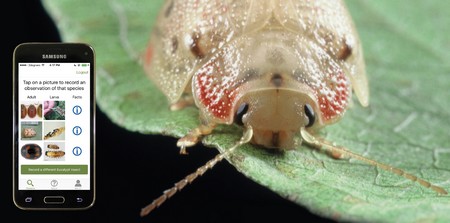Calling all citizen scientists

A smartphone app has been developed to give the public a new way to report sightings of eucalyptus pests.
A new tool for biosecurity response
New Zealand’s economy is reliant on the health of our primary industries. That is one reason why we take biosecurity so seriously - it just takes one breach to wreak havoc. How we manage the pests that have slipped through the net is another challenge altogether.
The ability to respond effectively to an incursion is dependent on finding it quickly, having good information about where it’s located and the likely rate and direction of spread. The response is informed by surveillance, and often involves the time consuming and labour intensive work from teams of people, methodically searching large areas. Dr Brian Richardson, Scion Principal Scientist, says “Effective surveillance is critical. If we know the exact distribution of a pest and its likely rate of spread we can more efficiently allocate resources in the response. But large scale surveillance needs a lot of eyes and ears on the ground which can be a real challenge.
“We’re always looking for new technologies and methods that will help improve surveillance efficiency. One improvement in biosecurity surveillance could be citizen science.”
Citizen science can work wonders – why not in biosecurity?
The logic behind citizen science is simple. By giving the public a channel to report information straight from the source, you can exponentially increase the amount of eyes on the ground. When it comes to pest surveillance, trying a citizen science approach makes sense.
Citizen science has already been used successfully in a range of fields including ecology, astronomy, and medicine. At its best, the sheer scale of data contributed from volunteers enables observations to occur over large geographic areas, faster and at much lower cost than professional teams.
The application for pest surveillance is simple. Brian says, “Knowing where the pest is, and its rate of spread, is essential for effective decision making. If you get that wrong, the eradication attempt is lost. You won’t succeed. If you have good information, you can make decisions about where to deploy resources according to priority, where to put restriction zones and what controls to implement. Everything comes from the knowledge of where the pest is. If engaging an army of volunteers enhances the rate and volume of useful data - that would be tremendously beneficial”.
In November 2016, Scion working with the Ministry for Primary Industries (MPI), the Forest Owners’ Association (FOA), Lincoln University, and NatureWatch NZ, launched a smartphone app to test whether a citizen science approach could work for reporting sightings of the eucalyptus variegated beetle.
Testing the waters
Paropsisterna variicollis, known as the eucalyptus variegated beetle, was first reported in the Hawke’s Bay in March 2016. Brian and his team seized the opportunity to test whether a citizen science approach would enhance surveillance. With funding from MPI and the FOA the ‘NZ Eucalyptus Pests’ smartphone app was created.
The app is built on the NatureWatch NZ platform, a popular online social media site for New Zealanders to upload and identify photographs (and sounds) of plants, and animals, and fungi. NatureWatch NZ is part of the global iNaturalist network operating from the California Academy of Sciences.
The ‘NZ Eucalyptus Pests’ app works in a similar fashion. Anyone who has downloaded the app can photograph and report possible beetle sightings. These photos are uploaded to NatureWatch NZ for initial identification and confirmed sightings are then assessed by MPI staff. The exact coordinates of observations are visible to authorised MPI and Scion staff but remain publicly obscured by 10 km on NatureWatch NZ.
If enough robust information is gathered, MPI and forest owners will be more informed for effective decisions on appropriate management controls.
The beauty of the app is its simplicity, it has been built to be easily customised to other pests. The possibilities are endless. Brian says, “If this goes well, we could possibly use this app structure for reporting symptoms of disease in foliage, other pests, weeds - you just have to imagine it really”.
NZ Eucalyptus Pests app available now!
The beetle has been found in the Hawke’s Bay and surrounds but your help is needed to know its spread.
The ‘NZ Eucalyptus Pests’ app can be downloaded free, from the Apple and Google Play stores.
To learn more about the eucalyptus variegated beetle see: www.mpi.govt.nz/protection-and-response/responding/alerts/eucalyptus-variegated-beetle
For further information
Contact Dr Brian Richardson at
Show email
Apple: https://itunes.apple.com/nz/app/nz-eucalyptus-pests/id1174688594?mt=8
Google Play store: https://play.google.com/store/apps/details?id=com.intranel.evbapp
